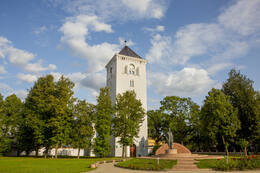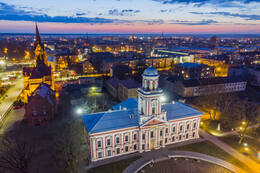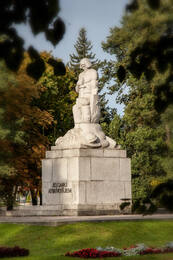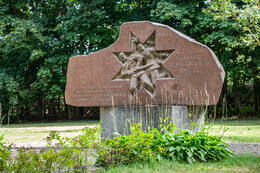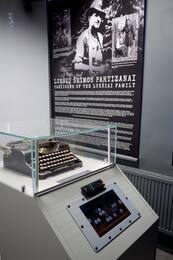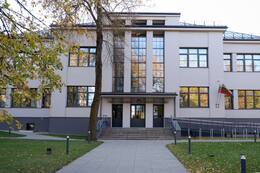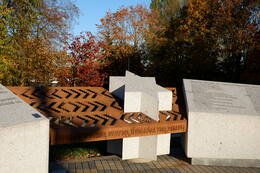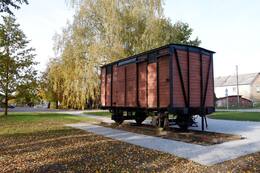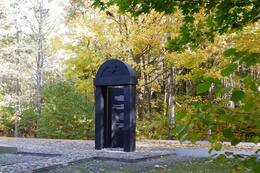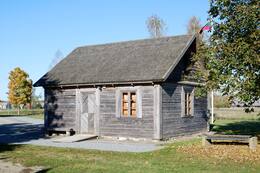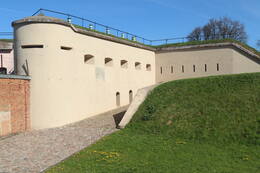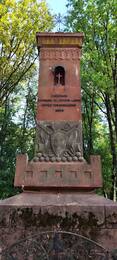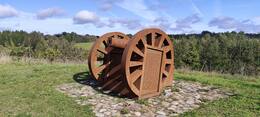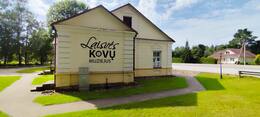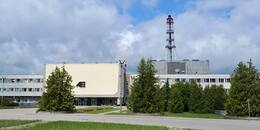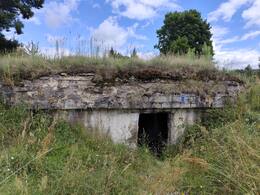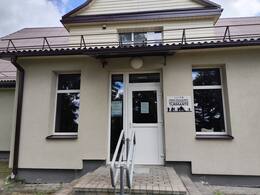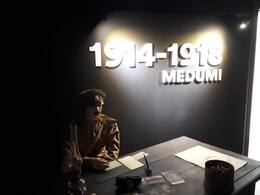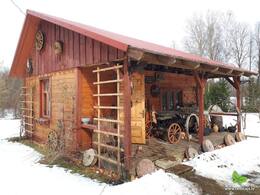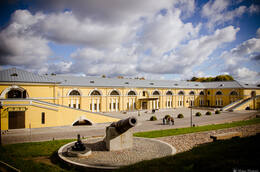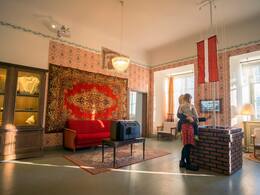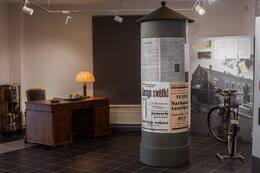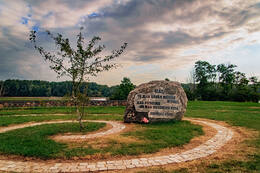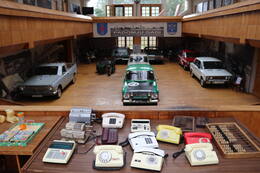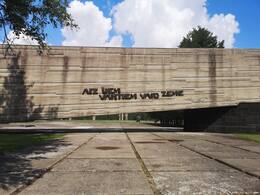Didysis pasienio karinio paveldo maršrutas Latvijoje ir Lietuvoje: 100 metų nepriklausomybės
Jelgavos Švč. Trejybės bažnyčios bokštas
Jelgavos Švč. Trejybės bažnyčios bokštas yra Jelgavos miesto centre. Bokštas stovi daugiau nei keturis šimtmečius ir yra tapęs ne tik miesto raidos, bet ir skaudžių įvykių liudininku. Bažny čios statyba pradėta 1574 m., vykdant Kuržemės ir Žiem galos hercogo Gothardo Ketlerio potvarkį. Jos bokštas buvo užbaigtas 1688 m., vadovaujant meistrui Martinui Knochui, ir tapo vienu labiausiai matomu miesto statinių. Antrojo pasaulinio karo metais Jelgava buvo smarkiai nu niokota, o bažnyčia sudegė 1944 m., po SSRS aviacijos antskrydžio. Po karo sovietų valdžia susprogdino altoriaus dalį, o sienos buvo nugriautos. Išliko tik bokštas kaip stra teginės reikšmės objektas, kadangi jis buvo aukščiausias mieste. Per karą ir pokariu bokštas buvo naudojamas ka rinėms reikmėms – iš jo buvo stebimos priešo pozicijos ir kontroliuojama aplinkinė teritorija. Pokario metais bokštas atliko strateginę funkciją, vykdant pasipriešinimo veiklą. Jis tapo slapta susitikimų vieta ir in formacijos, svarbios kovai su sovietiniu režimu, perdavimo vieta. Šiandien bokštas, išlaikęs savo istorinę reikšmę, atgi mė kaip kultūros ir švietimo centras.
G. Eliaso Jelgavos istorijos ir meno muziejus
G. Eliaso Jelgavos istorijos ir meno muziejus įsikūręs pastate, vadinamame Academia Petrina (Petro akademija). Jis buvo pastatytas 1775 m. kaip pirmasis universitetas Latvijoje ir yra vienas iš nedaugelio Jelgavoje Jelgavoje išlikusių ir po Antrojo pasaulinio karo restauruotų visuomeninių pastatų. 1944-ųjų vasarą Jelgava prarado beveik viską – didelę dalį gyventojų ir istorinių pastatų, kurių dauguma po Antrojo pa saulinio karo taip ir nebuvo atstatyti. Dabartinio muziejaus pirmtakas – Kuržemės provincijos muziejus, įkurtas 1818 m. Tai buvo antras pagal senumą muziejus Latvijoje ir pirmasis už Rygos ribų. Nuo 1952 m. pastate veikia Academia Petri na muziejus. Šiandien muziejuje veikia nuolatinės parodos apie iškilų Latvijos menininką Ģedertą Eliasą (1887–1975), priešistorę ir viduramžius Žiemgaloje bei Jelgavos miestą įvairiais laikotarpiais – Kuržemės ir Žiemgalos kunigaikštys tės (1561–1795 m.), Kuržemės gubernijos (1795–1918 m.) ir nepriklausomos Latvijos valstybės (1918–1940 m.) Muziejaus ekspozicija „Gyvenimas tęsiasi valdant sveti miems“ pasakoja apie gyvenimą Latvijoje vokiečių ir so vietų okupacijų metais. Virtualioje muziejaus parodoje „Karai ir kareivis Jelgavos amžiais“ galima susipažinti su įvairiais Jelgavą palietusiais karais, įskaitant ir Pirmojo bei Antrojo pasaulinių karų isto rinius įvykius.
Paminklas Jelgavos išvaduotojams „Lačplėsis“ (Lāčplēsis)
Paminklas Jelgavos išvaduotojams „Lačplėsis“ stovi Jelga voje, Stoties parke, priešais geležinkelio stoties pastatą. Jis buvo atidengtas 1932 m. birželio 22 d., dalyvaujant tuome tiniam Latvijos prezidentui A. Kviesiui. Paminklas skirtas 1919 m. lapkričio 21 d. įvykusiam Jelgavos išvadavimui, Latvijos nepriklausomybės karų metu, atminti. Per pirmąją sovietų okupaciją 1940 m. paminklas išliko ne paliestas. Tačiau 1941 m., kai sovietus pakeitė vokiečių oku pacinė valdžia, paminklo dviprasmiška simbolika nepatiko į Jelgavą sugrįžusiam vokiečių okupacinės administracijos vadovui fon Medemui – jo protėviai buvo pirmieji Jelgavos pilies statytojai. 1942 m. spalio 31 d. vokiečių okupacinė val džia įsakė paminklo autoriui Karliui Jansonui pašalinti vokiečių riterio atvaizdą. 1950 m. sovietų okupacinė valdžia įsakė paminklą sunaikinti. Lačplėsio skulptūra buvo nuversta nuo postamento su trak toriumi, sudaužyta, o jos likučius mėginta sutrupinti akmenų trupintuvu. Tačiau Lačplėsis pasirodė esąs toks kietas, kad tru pintuvas sugedo. Nesunaikinta paminklo vidurinė dalis buvo slapta užkasta vaikų darželio teritorijoje. 1988 m. ši paminklo dalis buvo surasta ir perkelta priešais G. Eliaso Jelgavos istorijos ir meno muziejų. Restauruotas pa minklas buvo iškilmingai atidengtas 1992 m. lapkričio 21 d. Jį atkūrė skulptorius Andrejus Jansonsas – paminklo autoriaus Karlo Jansono sūnus.
Paminklas Jelgavos gynėjams
Paminklas Jelgavos gynėjams stovi Jelgavos apylinkė se, prie Svėtės mokyklos. Jis skirtas Daugavgryvos krašto apsaugos kariams, kurie 1915 m. balandžio pabaigoje sustabdė vokiečių kariuomenės veržimąsi į Jelgavą. 1915 m. gegužės pradžioje Jelgavoje buvo surengta iškilminga demonstracija, skirta šiam svarbiam įvykiui paminėti. Tai, kad latvių krašto apsaugos kariams pavyko sulaikyti vo kiečių puolimą, tapo svarbiu argumentu – Janis Čakstė ir jo bendraminčiai tuo pasinaudojo siekdami įgyvendin ti idėją kurti latvių šaulių dalinius Pirmojo pasaulinio karo metais.
Paminklas buvo atidengtas 1991 metais, o jo autorė – skulptorė Alina Veibach (1923–2011).
Elėjos karo muziejus
Muziejus įsikūręs Elėjoje, buvusios geležinkelio stoties pas tate.
Elėjos karo muziejų įkūrė draugija „Žiemgalos šaulys“, ku rios nariai aktyviai prisideda šviesdami visuomenę, reng dami ekspozicijas, parodas ir edukacines veiklas. Pagrindinė muziejaus ekspozicija daugiausia skirta Antra jam pasauliniam karui. Joje eksponuojamos uniformos, ekipuotė, ginkluotė ir to laikotarpio fotografijos. Muziejuje galima nusifotografuoti vilkint įvairių istorinių laikotarpių ir kariuomenių uniformas. Nedideliame dviejų aukštų pasta te saugoma keli šimtai karinio paveldo eksponatų. Be to, yra eksponatų, susijusių su Elėjos miestu ir apylinkėmis, jo istorija ir įžymiomis asmenybėmis.
Joniškio istorijos ir kultūros muziejus
Joniškio istorijos ir kultūros muziejus yra įsikūręs Joniškio miesto centre. Muziejus veikia nuo 1989 metų, jame pristatomos ekspozicijos, reprezentuojančios krašto istorijos ir archeologijos vertybes, etninės kultūros ir sakralinio meno paveldą.
Istoriko ir muziejininko, partizaninio judėjimo tyrinėtojo Dariaus Vičo iniciatyva muziejuje buvo įrengta Joniškio krašto partizanams skirta ekspozicija. Atskiroje patalpoje pristatomos už Lietuvos laisvę kovojusių partizanų asmenybės bei jų kova su sovietų okupacine valdžia.
Ekspozicijoje pristatoma autentiška spausdinimo mašinėlė “Olympia“, tarnavusi paskutiniems Joniškio krašto partizanams Kostui Liuberskiui-Žvainiui ir Steponui Erstikiui-Patašonui: ja buvo spausdinami partizanų periodinio leidinio „Partizanų šūvių aidas“ numeriai. “Partizanų šūvių aidas” - pogrindinis laikraštis, leistas 1952–1957 m. Juozapavičiaus tėvūnijos teritorijoje (Akmenės, Joniškio, Žagarės ir Kuršėnų rajonų paribiuose). Tai – vėliausiai ėjęs partizanų periodinis leidinys.
Spausdinimo mašinėlė pritaikyta interaktyviam pažinimui – spaudžiant jos klavišus, lankytojas pamato nuotraukas ir išgirsta partizaninio pasipriešinimo istorijas. Eksponuojamas radijo imtuvas taip pat leidžia pasiklausyti partizanų kūrybos dainų.
Šiaulių istorijos muziejus
Šiaulių istorijos muziejus stovi Aušros alėjoje, Šiaulių miesto centrinėje dalyje. Muziejus duris po rekonstrukcijos atvėrė 2022 m. Jis yra įkurtas istoriniame „Aušros“ muziejaus pastate, pastatytame 1932 metais pagal vietos architekto Vlado Bitės projektą. Iš pradžių pastate veikė mokykla, o 1933 metais jo dalis buvo atiduota muziejui.
Šiandien Šiaulių istorijos muziejuje susitinka naujausios technologijos ir tradicinė muziejininkystė, veikia moderni atvirų saugyklų ekspozicija, pristatoma Šiaulių miesto istorija nuo pirmųjų žinių apie vietovę iki nepriklausomos Lietuvos Respublikos paskelbimo 1918 metais.
Dalis ekspozicijos skirta karo tematikai. Pirmo aukšto salėje pateikiamas atkuriamosios dokumentikos filmas apie Šiaulių žemėje vykusį Saulės mūšį, pateikiami eksponatai (daiktai, dokumentai, nuotraukos), susieti su Pirmuoju pasauliniu karu, mat jo metu miestas buvo stipriai nuniokotas, nukentėjo tiek gyventojai, tiek infrastruktūra. Ekspozicijoje pristatomos ir kovos su bermontininkais, 1919 m. užėmusiais miestą, siautėjusiais ir plėšusiais namus.
Šiaulių istorijos muziejaus ekspozicijų turinį išplečia edukacinės erdvės bei lauko ekspozicija. Daugiafunkcei muziejinei veiklai vykdyti skirta ir parodų-renginių salė.
Sukilėlių kalnelis
Sukilėlių kalnelis – smėlio kalva Šiaulių miesto vakarinėje dalyje, kurios istoriją paveikė abu pasauliniai karai.
Vieta liūdnai pagarsėjo dar 19 a. II p.: kalnelyje buvo palaidoti 1863–1864 m. sukilimo prieš carinės Rusijos Imperijos priespaudą dalyviai, nubausti mirties bausme. Apie vietą pradėjo sklisti kraupios legendos, ji buvo apleista ir retai lankoma, galiausiai praminta Sukilėlių kalneliu. I pasaulinio karo metais jame buvo palaidoti Vokietijos imperijos kareiviai.
1926 m. kalnelį pradėta tvarkyti. Miesto inžinierius Karolis Reisonas pasisiūlė parengti paminklo-obelisko, skirto sukilėliams, projektą. 1928 m. sukilėlių kalnelyje įvyko Lietuvos nepriklausomybės 10-ųjų metinių minėjimas, atidarytas Nepriklausomybės sodas, tačiau paties paminklo statybos buvo užbaigtos tik 1935 m. Pastatytas paminklas – 14 m aukščio rausvo granito obeliskas – buvo atidengtas ir pašventintas, perlaidoti čia rastų sukilėlių palaikai.
II pasaulinio karo metais kalnelyje buvo palaidoti 1941–1944 m. žuvę Vokietijos Reicho kariai.
Sovietinės okupacijos metais antkapiniai paminklai buvo demontuoti, o 1955–1957 m. Sukilėlių kalnelio paminklas-obeliskas rekonstruotas – pašalinta visa tautinė ir religinė simbolika. 1988 m., minint 125-ąsias sukilimo metines, autentiškas paminklo vaizdas buvo atkurtas.
Pasaulio tautų teisuolių skveras (paminklas)
2021 m. spalio 22 d. Šiauliuose, Ežero ir Vilniaus gatvių sankirtoje buvo atidarytas Pasaulio Tautų Teisuolių skveras. Tai pirmasis paminklas Pasaulio Tautų Teisuoliams Lietuvoje. Paminklo autorius – iš Šiaulių kilęs dizaineris Adas Toleikis, o iniciatorius Šiaulių apskrities žydų bendruomenės pirmininkas Sania Kerbelis.
Sukurtame monumente „Jungtis“ iškaltos Šiaulių apskrities Pasaulio Tautų Teisuolių pavardės, įamžinančios 148 žydų gelbėtojus, o meniniai akcentai žymi Šiaulių getų vartų vietas. Šiaulių mieste buvo įsteigti du getai: vadinamajame Kaukazo kvartale ir Ežero–Trakų g. kvartale. Į pirmąjį getą buvo siunčiami fiziškai stiprūs ir darbui tinkami asmenys, į antrąjį – specialistai (gydytojai, mechanikai ir kiti). Getas Šiauliuose buvo įsteigtas 1941 m. vasarą Šiaulių miesto karo komendanto nurodymu, o likviduotas 1944 m., nacistinei Vokietijai traukiantis ir likusius žydus pervežus į Štuthofo ir Dachau koncentracijos stovyklas. Getuose buvo įkalinta daugiau kaip 5950 žydų. Tarpukariu Šiauliuose gyveno apie 6500–8000 žydų, dalis jų savo noru pasitraukė į Rusijos gilumą, o po holokausto liko vos apie 350–500 žydų kilmės gyventojų.
Trėmimų traukinio vagonas
Netoli Radviliškio traukinių stoties yra pastatytas atkurtas trėmimų traukinio vagonas, primenantis tragišką istorijos puslapį, kai 1941-1952 m. okupacinė Sovietų valdžia masiškai deportavo Lietuvos Respublikos gyventojus į atokias Sovietų Sąjungos vietoves. Vien iš Radviliškio miesto buvo ištremta daugiau, nei 3000 gyventojų.
Iš viso 1941–1952 m. iš Lietuvos buvo ištremta apie 135 500 žmonių. 1941 m. birželio 14-ąją – pirmąją masinių trėmimų Lietuvoje – dieną į trėmimo traukinių vagonus pradėti „talpinti“ Radviliškio miesto ir apylinkių gyventojai.
2012 m. vagoną, tarpininkaujant Lietuvos gyventojų genocido ir rezistencijos tyrimo centrui, Radviliškio rajono savivaldybei neatlygintinai perdavė Lietuvos kariuomenės Specialiųjų operacijų pajėgų Vytauto Didžiojo jėgerių batalionas. Autentiškas trėmimų vagonas buvo parvežtas iš Kauno, kruopščiai atkurtas geležinkelininkų, dabar jame veikia nedidelė ekspozicija.
Šeduvos žydų I ir II holokausto vietos
Šeduvos I ir II holokausto vietos yra Liaudiškių miške (Radviliškio r.), apie 10 km į pietvakarius nuo Šeduvos. Žvyrkelyje pastatyta lankytino objekto nuoroda.
Pirmoji žydų tautybės žmonių palaikų kapavietė užima mišku apsuptą 375 m² dydžio teritoriją, kurios didesnė dalis išgrįsta akmenimis. Šioje vietoje nužudyta ir užkasta apie 400 žmonių. Už maždaug 500 m yra antroji kapavietė. Žydų tautybės žmonių palaikai palaidoti 144 m² dydžio teritorijoje. Aikštelės reljefas lygus, didesnė dalis teritorijos taip pat išgrįsta akmenimis. Šioje vietoje nužudyta ir užkasta apie 300 žmonių.
1941 m. šiose vietose buvo nužudyta visa Šeduvos miestelio žydų bendruomenė – beveik 700 žmonių. Prieš tai jie dar mėnesį praleido Pavartyčių kaime įkurtame gete. Rugpjūčio 25-26 d. geto gyventojai buvo išvežti į Liaudiškių mišką. Prie iškastos duobės buvo atvaromi pasmerktieji, kuriuos vokiečių įsakymu nužudė vietiniai policininkai ir baltaraiščiai tarp nužudytųjų buvo 230 vyrų, 275 moteris ir 159 vaikai.
2014-2015 m. Šeduvos žydų memorialinio fondo iniciatyva žudynių vietos buvo sutvarkytos ir pritaikytos lankymui. Žudynių vietose įrengti 2 skulptoriaus Romo Kvinto paminklai: „Durys“ ir „Spindulys-žvaigždė“.
Lietuvos Laisvės Kovos Sąjūdžio memorialas Minaičiuose (Minaičių bunkeris-muziejus)
1948 m. rudenį Prisikėlimo apygardos štabas ieškojo vietos žiemojimui, tam buvo pasirinkta partizanų rėmėjų A. ir S. Miknių sodyba Minaičių kaime (Radviliškio r.). Partizanai po klėtele išsikasė nedidelį bunkerį, kuriame apsigyveno apygardos štabo nariai.
1949 m. vasario 16 d. partizanų vadai Minaičiuose baigė sudaryti ir paskelbė Lietuvos Laisvės Kovos Sąjūdžio deklaraciją, kurios pagrindinis tikslas - Lietuvos parlamentinės respublikos atkūrimas 1920–1926 m. pavyzdžiu. Oficialiai posėdžiuose dalyvavo 8 asmenys: Jonas Žemaitis-Vytautas, Juozas Šibaila-Merainis, Petras Bartkus-Žadgaila, Adolfas Ramanauskas-Vanagas, Aleksandras Grybinas-Faustas, Vytautas Gužas-Kardas, Leonardas Grigonis-Užpalis ir Bronius Liesys-Naktis.
Bunkeris buvo naudojamas ir vėliau, jame partizanė farmacininkė Izabelė Vilimaitė-Stirna gydė Užpelkių kautynėse sunkiai sužeistą partizaną Lauryną Mingilą-Džiugą. 1953 m. nebegyvenamas bunkeris įgriuvo ir buvo užverstas šeimininkų.
2010 m. pradėti partizanų bunkerio, sodybos klėties atkūrimo ir paminklo statymo darbai. Skulptoriaus Jono Jagėlos sukurtame paminkle įamžinti visų aštuonių deklaraciją pasirašiusių partizanų vardai. Klėtyje įrengtas autentiškas, stiklu dengtas, partizanų bunkeris, kurį lankytojai gali apžiūrėti iš viršaus, o klėtyje įrengta ekspozicija.
Kauno IX forto muziejus
Kauno IX forto muziejus įsikūręs svarbių tarptautinių susisiekimo kelių sankryžoje šalia Kauno ir yra patogiai pasiekiamas automobiliu.
IX fortas buvo pastatytas kaip vienas iš Kauno tvirtovės komplekso fortų 1903–1913 m. ir turėjo tikslą apsaugoti strategiškai svarbias Linkuvos aukštumas. Jis buvo statomas naudojant tuo metu naujoviškas betonines perdangas, jame įrengta elektros ir priverstinė ventiliacijos sistema. Pirmojo pasaulinio karo metais fortas nenukentėjo. 1924–1940 m. IX forte veikė kalėjimas, kuriame buvo kalinami politiniai ir kriminaliniai kaliniai, o 1940–1941 m. kalėjimas tapo NKVD perskirstymo punktu. Antrojo pasaulinio karo metais IX fortas virto masinių žydų žudynių vieta, kurioje nacistinis okupacinis režimas nužudė apie 50 000 žydų iš įvairių valstybių. 1958 m. IX forte buvo įkurtas muziejus, kuris pasakojo apie nacių nusikaltimus, 1984 m. įrengtas memorialinis kompleksas ir pastatytas monumentas nacizmo aukoms atminti (Alfonsas Vincentas Ambraziūnas, Gediminas Baravykas ir Vytautas Vielius). Šiandien IX forto muziejuje pasakojama forto bei nacių ir sovietų vykdytų nusikaltimų istorija.
KGB branduolinio bunkerio muziejus
Kauno branduoliniame bunkeryje, esančiame 6 m gylyje po žeme, įrengtas muziejus su privačių kolekcininkų eksponatais (> 1200). Įdomiausi iš jų – dujokaukių kolekcija ir didžiausia Šaltojo karo radijo įrangos bei šnipinėjimo prietaisų paroda Baltijos šalyse.
Lietuvos Respublikos Seimo Sausio 13-osios memorialas
Vilniaus mieste, prie Lietuvos Respublikos Seimo II rūmų
1991 m. sausį laisvės siekusių ir ją gynusių Lietuvos žmonių pastangomis Lietuvos parlamento rūmai buvo apjuosti barikadų užtvara. Barikadomis mėginta apsisaugoti nuo tuo metu kilusios Sovietų Sąjungos karinės agresijos – sovietų mėginimų įvykdyti valstybinį perversmą Lietuvoje ir sugrąžinti sovietinę valdžią. Jos parlamentą juosė iki 1992 m. pabaigos. 1993 m. prie Lietuvos Respublikos Seimo rūmų iš dalies barikadų ir kitų reliktų buvo sukurtas savotiškas memorialas – Lietuvos žmonių pasiaukojimo įamžinimui skirtas paminklas.
Sausio 13-oji – tragiškiausias 1991 m. sausio mėnesio įvykis, kai sovietų kariuomenei ir specialiesiems daliniams užimant Lietuvos radijo ir televizijos pastatą bei Televizijos bokštą, žuvo 14 laisvės gynėjų ir apie 600 žmonių sužeista – buvo paskelbta atmintina Laisvės gynėjų diena. Artėjant dešimtosioms Laisvės gynėjų dienos metinėms buvo nuspręsta apsaugoti minėtą kompoziciją, įrengiant Sausio 13-osios memorialą. Memorialas atidengtas 2008 m.
Memoriale išsaugotas autentiškas 1991 m. parlamento barikadų fragmentas, įrengta koplyčia su Švč. Mergelės Marijos atvaizdu, eksponuojami per 1991 m. sausio įvykius žmonių sunešti daiktai, supažindinama su Lietuvos nepriklausomybės apgynimo įvykiais. Teigiama, kad tai bene vienintelis pasaulyje tokio tipo paminklas, įprasminantis parlamento ir valstybės nepriklausomybės gynimą.
Paminklas žuvusiems 1920 m. mūšiuose
Paminklas randasi Giedraičių miestelyje.
1932 m. birželio 19 d. buvo atidengtas žuvusiems už Lietuvos laisvę paminklas Giedraičiuose. Paminklo statybos iniciatoriais buvo Giedraičių gyventojai – dailininkas ir paminklo autorius Antanas Jaroševičius, kunigas Meigys, Lietuvos karius mūšyje rėmę Malvina Valeikienė ir Matas Valeika, Širvintų visuomenė bei Lietuvos kariuomenė surinko paminklui 11 000 litų. Kvietime aukoti paminklo statybai nurodoma, kad paminklas statomas „laimėjimui pagerbti ir amžinam mūsų džiaugsmui, jis primins tos vietos istorišką reikšmę, taip pat reikš pagarbą Giedraičiuose palaidotiems kariams.“
Paminklo atidengimo ceremonija buvo pompastiška, joje dalyvavo Lietuvos Respublikos prezidentas A. Smetona, kariuomenės vadas, 2, 4, 7, 9 pulkų atstovai ir karininkai, kurie dalyvavo kautynėse Giedraičiuose. Prie paminklo iš karo lėktuvų buvo numestos gėlės, žymi lietuvių veikėja ir viena iš paminklo statybos organizatorių Malvina Valeikienė perskaitė prie Giedraičių žuvusių Lietuvos karių pavardes, jai buvo įteiktas 3-jo laipsnio Vyčio Kryžiaus ordinas, prie paminklo buvo pašventinta vietos šaulių būrio vėliava. 1962–1964 m. sovietinės administracijos nurodymu paminklą nesėkmingai mėginta nugriauti, o vėliau jis paskelbtas istorijos paminklu.
Stilizuotas pabūklas Giedraičių mūšio 100-čiui paminėti
200 m išsukus iš 172 kelio nuo Giedraičių miestelio.
2020 m. lapkričio 21 d. pergalei atminti Giedraičių mūšio vietoje, ant kalvos atidengtas skulptoriaus Džiugo Jurkūno sukurtas paminklas. Paminklas naujai interpretuoja tarpukaryje vykusias Lietuvos kariuomenės kovas su Lenkijos kariuomene, siekiant atsisakyti konfliktinio pasakojimo, akcentuoja abiejų valstybių sąjungos reikšmę dabarties įvykių kontekste. Rūdimis padengtas pabūklas vaizduoja tvirtą sąjungą tarp prieš šimtą metų kariavusių Lietuvos ir Lenkijos. Paminklo šonuose aprašyta tuometinė situacija, paminėti jame dalyvavę Lietuvos ir Lenkijos kariuomenių daliniai bei trumpai pristatyta mūšio eiga. Paminklas pastatytas Lietuvos kariuomenės iniciatyva ir lėšomis.
Laisvės kovų muziejus Utenoje
Utenoje, netoli nuo magistralinių kelių Kaunas–Daugpilis (A6) ir Vilnius–Utena (A14) sankirtos.
Muziejus 2015 m. įsikūrė buvusioje Utenos siaurojo geležinkelio stotyje. Kaip prisistatoma – tai poezija alsuojantis ir subtiliai pokario tiesą atskleidžiantis muziejus. Ekspozicijoje „Bendras Europos identitetas totalitarinių režimų kontekste“ siūloma per vieno Lietuvos krašto istoriją pažinti visos Lietuvos ir Europos praeitį. Pasakojama apie Europos padalijimą 1939 m. pagal slaptų protokolų susitarimus, sovietinę Lietuvos okupaciją, lietuvių prievartinį dalyvavimą Antrajame pasauliniame kare, tremtį, pokario rezistenciją ir kolūkių kūrimą Utenos krašte. Skaudūs 1940–1965 m. Utenos krašto ir Lietuvos įvykiai atskleidžiami juos kontrasto principu palyginant su gyvenimu už geležinės uždangos.
Siaurojo geležinkelio stoties istorijoje taip pat esama tragiško įspaudo. Iš čia 1941 ir 1945–1953 m. į Sibirą riedėjo vagonai su tremtiniais.
Ignalinos atominė elektrinė
6 km nuo Visagino, vykstant keliu Visaginas–Ignalinos atominė elektrinė (KK177).
Tai vienintelė Baltijos šalyse buvusi atominė elektrinė. Kai kada ji dar vadinama Černobylio atominės elektrinės „seserimi“, mat abejose elektrinėse statyti sovietų gamybos RBMK tipo reaktoriai. Pirmasis Ignalinos elektrinės reaktorius (energetinis blokas) buvo paleistas 1983 m. Iš viso planuota pastatyti keturis tokius reaktorius. Pastačius juos visus Ignalinos atominė elektrinė turėjo tapti galingiausia pasaulyje.
Antrasis reaktorius turėjo būti paleistas 1986 m., tačiau įvykus avarijai Černobylio atominėje elektrinėje jo paleidimas nukeltas. 1987 m. jis visgi buvo paleistas. 1988 m. Lietuvos Persitvarkymo Sąjūdžio iniciatyva prie elektrinės buvo surengta akcija „Gyvybės žiedas“ prieš trečiojo bloko statybas. Jo statyba buvo užkonservuota, o 1989 m. ir sustabdyta. Po avarijos Černobylyje RBMK tipo reaktorių saugos sistema buvo modernizuota, tačiau jų plėtra sustojo.
Ignalinos atominė elektrinė buvo įrašyta į Gineso rekordų knygą. Dar kartą ji išgarsėjo 2019 m. kaip HBO ir Sky UK televizijos miniserialo „Černobylis“ filmavimo aikštelė.
2010 m. pradėti atominės elektrinės uždarymo darbai. Uždaromoje elektrinėje organizuojamos ekskursijos, įrengta ekspozicijos salė.
Vokiečių kariuomenės atramos punkto blindažai Tilžės kaime
Tilžės kaime prie pat 5303 kelio.
1915–1918 m. Vokietijos 8 armijos 88 divizijos šiame fronto ruože kovojusios su Rusijos kariuomene atramos punkto blindažas, kuris skirtas apsaugoti karius nuo galingų ugnies smūgių. Visos tokio pobūdžio slėptuvės buvo statomos pagal tipinę schemą, skyrėsi tik statinių dydžiai. Slėptuvė-vadavietė pastatyta naudojant tvirčiausią įmanomą statybinę medžiagą – betoną ir armatūrą, fasadinės slėptuvės-vadavietės sienos kraštuose išsidėstę du įėjimai, tarp kurių nedidelė langelių eilė, įvesta elektra, atvestas vanduo iš netoliese įrengto šulinio, įrengtos dvi krosnys, mediniai suolai ir gultai. Karininkams, ryšio mazgams, tvarstomajam skirtos slėptuvės-vadavietės patalpos buvo balintomis sienomis. Ant blindažo švelerių (metalo lovių) išlikę užrašai „88 J.D.T.“ nurodo, kad jie pagaminti 88 divizijos daliniuose.
Pirmojo pasaulinio karo Vokietijos kariuomenės blindažas (vadavietė)
Kimbartiškės kaime, išsukus iš 5303 kelio.
1915–1918 m. Vokietijos 8 armijos 88 divizijos šiame fronto ruože kovojusios su Rusijos kariuomene blindažas-vadavietė, kuri skirta apsaugoti karius nuo galingų ugnies smūgių. Visos slėptuvės buvo statomos pagal tipinę schemą, skyrėsi tik statinių dydžiai. Slėptuvė-vadavietė pastatyta naudojant tvirčiausią statybinę medžiagą – betoną ir armatūrą, fasadinės sienos kraštuose išsidėstę du įėjimai, tarp kurių nedidelė langelių eilė, slėptuvėje-vadavietėje įvesta elektra, atvestas vanduo iš netoliese įrengto šulinio, dvi krosnys, mediniai suolai ir gultai. Karininkams, ryšio mazgams, tvarstomajam skirtos patalpos buvo balintomis sienomis.
Čia esantis masyvus statinys pastatytas išnaudojant reljefo nelygumus ir įkomponuotas nedidelėje dauboje. Tai pasyvaus fortifikacinio statinio pavyzdys. Pasyvieji statiniai nebuvo pritaikyti aktyviai gynybai. Jie skirti apsaugoti karius ir amuniciją nuo sunaikinimo artilerijos ugnimi. Šio objekto viduje išlikusios sienų balinimo žymės. Objektas įvardijamas kaip buvusi vadavietė.
Pirmojo pasaulinio karo ekspozicija Turmante
Zarasų rajone esančiame Turmanto miestelyje.
Pirmojo pasaulinio karo metais Turmantas buvo svarbus Rytų frontą gynusios Vokietijos kariuomenės 88 divizijos logistikos taškas. Pirmojo pasaulinio karo ekspozicija Turmante yra tarptautinio maršruto ,,Pirmojo pasaulinio karo takais“ sudėtinė dalis ir yra įsikūrusi Turmanto pagrindinės mokyklos pastate. Šiuolaikinėje ir virtualia realybe papildytoje ekspozicijoje rasite daug Pirmojo pasaulinio laikų unikalių artefaktų, replikų ir nuotraukų, taip pat susipažinsite su karių kovos ir gyvenimo Rytų fronte sąlygomis, ginklais ir amunicija, uniformomis bei ekipuote.
Pirmojo pasaulinio karo muziejus
Aršiausi Pirmojo pasaulinio karo mūšiai Latvijos teritorijoje vyko netoli Daugpilio – 1915 m. rugpjūtį ir spalį Ilūkstės ir Medumų aukštumose. Vokiečiai bandė prasiveržti į Daugpilį, tačiau rusai juos nustūmė atgal. Nė viena pusė neįgijo pranašumo, todėl abi pusės ėmė kasti apkasus ir suformavo trijų linijų ešelonuotos gynybos padėtis. Abiem pusėms nesisekė, todėl jos ėmė statyti tranšėjas, kurdamos nuodugnios gynybos pozicijas, sudarytas iš trijų linijų. Pirmojo pasaulinio karo muziejus Medumuose skirtas šiems mū šiams atminti. Pirmoji ekspozicijos dalis supažindina su Medumų krašto istorija ir rodo, kad prieš karą tai buvo gausiai gyvenama ir išvystyta vietovė.
Antroji dalis pasakoja apie Pirmojo pasau linio karo įvykius Europoje ir Latvijoje, pristato karių gyvenimo sąlygas bei karo metu atsiradusias naujoves, taip pat ekspo nuojami vokiečių ir rusų kariuomenių naudoti ginklai. Trečiojoje ekspozicijos salėje lankytojai gali įsijausti į kareivio gyvenimą – čia atkurta rusų bunkerio kopija su apkasų fragmentu, nedi dele slėptuve, karo lauko atributais ir kareivių manekenais. Ka dangi mediniai rusų kariuomenės bunkeriai iki šių laikų neišliko, jie rekonstruoti muziejaus ekspozicijoje, o betoninius vokiečių kariuomenės bunkerius galima pamatyti keliaujant tarptautiniu maršrutu, vedančiu per Pirmojo pasaulinio karo vietas. Bunke rio imitacijos salėje naudojama garso ir vaizdo įranga sukuria autentišką karo lauko atmosferą.
Pirmojo pasaulinio karo vietos istorijos kolekcija Medumo mieste
Įsikūręs Medumu kaime, Jaunatnes g. 4.
Stikānsų šeimos sukurta privati istorinių įrodymų kolekcija. Sukurta Pirmojo ir Antrojo pasaulinių karų artefaktų kolekcija, daugiausia surinkta Medumi parapijoje ir apylinkėse. Galima apžiūrėti tiek karinio paveldo daiktus, tiek namų apyvokos daiktus, monetas ir nuotraukas.
Privačią kolekciją galima apžiūrėti iš anksto susitarus. Įėjimas – už aukas.
Karinės technikos muziejus Sventėje
Muziejus yra prie viešbučio „Sventes muiža“. Jo ekspozicija išskiria tuo, kad dauguma eksponatų yra rasti buvusių mūšių laukuose. Sovietų armijos karinė tech nika yra meistriškai restauruota – kai kuriuos eksponatus galima užvesti ir pademonstruoti jų veikimą. Manoma, kad eksponuojami tankai yra reti egzemplioriai Europos mastu. Muziejuje galima pamatyti:
• sovietų armijos tankus – vidutinį tanką T-34 ir sunkiuo sius tankus IS-2 ir IS-2M, pavadintus Stalino garbei;
• šarvuotas desanto žvalgybos transporto priemones BRDM-2 ir BRDM-1;
• karines transporto priemones „Jeep Willys“ ir „GAZ 67“;
• savaeiges transporto priemones;
• patrankas ir kitą karinę techniką
Daugpilio šratų gamykla
Daugpilio šratų gamykla, įkurta 1885 m., yra seniausia šaudmenų gamykla Šiaurės Europoje. Tai vienintelė tokio tipo gamykla Baltijos šalyse ir vienas seniausių pramoninio paveldo objektų Latvijoje. Joje veikia vienintelis Europoje švino šratų liejimo bokštas. Gamykla jau daugiau nei šimtmetį gamina aukštos ko kybės medžioklinius šratus ir šią veiklą tęsia iki šiol. Joje iš likę XIX a. įrenginiai ir konstrukcijos, sumontuoti Pirmojo ir Antrojo pasaulinio karų metu. Šiuo metu šratų gamybai naudojama ir moderni įranga.
Lankytojai gali apžiūrėti istorinę ekspoziciją, šratų liejimo cechą ir užlipti į unikalų 31,5 m aukščio bokštą, po kuriuo yra 13,5 m gylio aušinimo šulinys. Gamykla yra populiari turistų lankoma vieta, pritraukianti tiek vietinius, tiek už sienio lankytojus, kurie gali susipažinti su XIX a. pramonės paveldu ir pamatyti, kaip veikia senoji technika. Apžiūrėję gamyklą lankytojai gali išbandyti joje gaminamus šratus gamyklos šaudykloje.
Daugpilio tvirtovė
Daugpilio tvirtovė – valstybinės reikšmės architektūros ir kul tūros istorijos paminklas. Tai paskutinė pasaulyje pastatyta bastioninio tipo tvirtovė ir vienintelis Vidurio Europoje išlikęs XIX a. pirmosios pusės tvirtovės pavyzdys, išlikęs be didesnių pokyčių. Tvirtovės statyba pradėta 1810 m., carinei Rusijai rengian tis Napoleono kariuomenės įsiveržimui, ir truko iki 1878 m. Dar nebaigus statybos, 1812 m., prie tvirtovės vyko rusų ir prancūzų karių mūšiai. Nors po Napoleono karų statybos buvo tęsiamos, jau tuomet tvirtovė ėmė prarasti savo ka rinę reikšmę. Pirmojo pasaulinio karo metais (1915–1918) tvirtovė buvo Rusijos kariuomenės logistikos ir palaikymo bazė. 1918 m.
vasarį ją užėmė vokiečių kariuomenė, o gruodį – bolševikai. 1920 m. sausį tvirtovę užėmė lenkų kariai, padėję Latvijos kariuomenei išlaisvinti Latgalą nuo bolševikų. Tarpukariu, 1920–1940 m., tvirtovėje buvo dislokuota Latvijos kariuome nės 4-oji Žiemgalos divizija. 1940 m. okupavus Latviją, tvirtovėje įsikūrė Raudonosios ar mijos daliniai, o vokiečių okupacijos metais čia buvo karo belaisvių stovykla „Stalag-340“. Po 1944 m. sovietų sugrįžimo tvirtovė vėl atiteko sovietinei armijai. Latvija tvirtovę atgavo tik 1993 m., kai iš jos pasitraukė Rusijos kariuomenė.
Jersikos nacionalinis partizanų žygių maršrutas
Gamtoje sunkiai randamas objektas.
Žygio ilgis: apie 22 km, įveikiamas maždaug per 6 valandas.
Sudėtingumo lygis: vidutinio sunkumo žygis.
Pradinis taškas: Jersikos pradinė mokykla (galima pasiekti traukiniu, autobusu).
Galutinis taškas: Vanagų bažnyčia (viešasis transportas savaitgaliais nekursuoja).
Pastaba: Maršrute yra maudymosi pertraukėlė (vasaros sezonu), žvejybos galimybės, iškylų vieta ir vienas viešasis tualetas. Maršrutas taip pat tinka mokyklinio amžiaus vaikams, kurie jau turi tokio ilgio žygių patirties.
Leiskitės į žygį iš Jersikos į Vanagus, leisdami sau išbandyti ištvermę, nes žygis veda per miškus, pelkes, viržynus, pievas ir kaimo takus, pažinti žymiausių nacionalinio partizaninio judėjimo veikėjų istoriją, jų veiklą, pamatyti reikšmingiausias vietas, apie kurias pasakojamos vietos legendos ir rašytiniai bendrapiliečių prisiminimai. Takas prasideda prie Jersikos pradinės mokyklos ir veda prie atminimo akmens po senu ąžuolu, toliau pakeliui – iki Jersikos geležinkelio stoties. Ant akmens iškaltas užrašas „LTS(p)A – Latvijos Tėvynės partizanų asociacijos kovotojams. LTS(p)A 1945–1955 m. vienijo šešių Latvijos rajonų nacionalinius partizanus kovoje su komunistiniu okupaciniu režimu“.
Pasivaikščiojimas tęsiasi geležinkelio bėgiais ir vingiuoja palei Jersikos ežerą, kur miškas siūlo gamtos lobius: pavasarį žydinčias raktažolės ir paprastąją viksvą. Artėjimą prie pelkės rodo raktažolės kvapas, tačiau pavasarį ypač stebina jų žydėjimas. Tingai pasivaikščioti neįmanoma, reikia įveikti kelis griovius, perėjus pelkę atsigaivinti – kiekviename žingsnyje samanose lieka vandens, krūmuose žiba spanguolių uogos. Pelkę pakeičia miškas ir šių vietų buvusios sodybos įrodymai – didingi ąžuolai, pastatų griuvėsiai, jaunuolynų apsupta nacionalinio partizanų bunkerio vieta. Takas tęsiasi iki vietos, liudijimuose minimos kaip Tėvynės sargybos (partizanų) draugijos įkūrimo vieta. Miško masyve taip pat slepiasi memorialinė vieta „Avotnīca“ („Olūtneica“), kur įrengtas laužavietė. Stebina miško įvairovė, kaip ir griovių plotis. Žygio tikslas – Vanagų bažnyčia, kurioje tarnavo kunigas A. Juhņevičs, apie kurį pasakojama filme „Segvārds Vientulis“ (rež. N. Pucis).
Paroda „Kovos už laisvę XX amžiuje“ Jėkabpilio istorijos muziejuje
Įsikūręs Krustpilio pilyje
Paroda „Kovos už laisvę XX amžiuje“
Sovietinės represijos. Sunkūs prisiminimai. Sėdėdami čia, klubo kėdėje, turite galimybę pasiklausyti Jėkabpilio gyventojo Ilmāro Knagio knygos „Buvo tokie laikai“ ištraukų. Ant vienos iš kambario sienų bejausmiškai, tarsi titrai po filmo, slenka į Sibirą ištremtų piliečių sąrašas. Ten pat, sename televizoriuje, galite žiūrėti mėgėjišką vaizdo įrašą apie Lenino paminklo pašalinimą Jėkabpilyje. Lankytojus domina ne tik turinys, bet ir techninės galimybės – kaip šis filmas buvo sukurtas sename televizoriuje.
Jekabpilio istorijos muziejuje galima pasiklausyti muziejaus specialistų parengtų paskaitų arba užsiregistruoti į ekskursiją: Jekabpilis ir jo apylinkės Pirmojo pasaulinio karo metu, Jekabpilis 1990 m., Barikadų metas, 1949 m. trėmimai – 70, Jėkabpiliečiai – Lačplėšio karo ordino kavalieriai ir kt.
Vidutinė paskaitų trukmė – 40 minučių. Informacijos ir registracijos į paskaitas teirautis telefonu 65221042, 27008136.
Jekabpilio istorijos muziejus įsikūręs Krustpilio pilyje. 1940 m., Latviją prijungus prie SSRS, Krustpilio pilyje buvo dislokuota 126-oji šaulių divizija. Antrojo pasaulinio karo metu pilyje buvo įsikūrusi vokiečių ligoninė, o po 1944 m. rugpjūčio mėn. – Raudonosios armijos karo ligoninė. Po karo Krustpilio pilyje ir gretimuose dvaro pastatuose buvo įsikūrę 16-ojo tolimojo nuotolio žvalgybos aviacijos pulko ir 15-osios sovietinės armijos oro armijos centriniai sandėliai.
Paroda „Latvijos armija Pliavinėse XX amžiuje“.
Adresas: Odzienas g. 2, Pļavinės.
Eksponuojama nuolatinė ekspozicija „Latvijos armija Pliavinėse XX amžiuje“.
Pastatas Pliavinėse, Odzienos gatvėje 2, turi ilgą istoriją – nuo tada, kai „Stukmaņi“ didmenininkas „Hugo Apeltofts“ pradėjo jame aktyvią ūkinę veiklą ir taip prisidėjo prie Pliavinių miesto plėtros, iki to momento, kai Nepriklausomybės karo metu čia buvo įkurtas Latvijos Rytų fronto štabas. 1919 m. būtent iš Pliavinių buvo vadovaujamos Latvijos armijos dalinių operacijos prieš Raudonąją armiją Latgaloje.
1934 m. prie šių namų buvo atidengta memorialinė lenta su užrašu: „1919 m. šiuose namuose buvo įsikūręs Rytų fronto štabas, o čia generolas Janis Balodis perėmė vyriausiąją Latvijos nacionalinės armijos vadovybę.“ Sovietų valdžia ją 1940 m. pašalino ir sunaikino, tačiau 1990 m. birželio 16 d., padedant Latvijos nacionalinės išlaisvinimo armijos Pliavinės skyriui, ji buvo atstatyta.
Dabar šalia buvusio štabo pastato stovi memorialinė stela, skirta 15 Lačplėsio Karo ordino riterių, gimusių Pliavinos krašte, o patalpose sukurta paroda „Latvijos armija Pliavinoje XX amžiuje“, kurioje pasakojama apie Laisvės kovų įvykius, Latvijos armijos 3-iosios Latgalos divizijos štabo veiklą Pliavinoje, taip pat galima susipažinti su Lačplėsio Karo ordino riterių gyvenimo istorijomis.
Netoli parodų pastato yra Latgalos divizijos štabo pastatas, kurį 1913 m. kaip „Stukmanu“ likerio fabriką pastatė grafas Teodoras Medemas. 1919 m. jį perėmė P. Stučkos režimas, kuriame taip pat buvo įkurtas kalėjimas. Išvijus bolševikus, 1925 m. pastatą perėmė Latvijos armija, kurioje buvo įsikūręs Latgalos divizijos štabas. Šiame pastate savo karinę karjerą praleido 10 Latvijos armijos generolų ir kitų karininkų. 1940 m. pastatą perėmė Raudonoji armija. Pokario metais jame buvo įsikūrusi mokykla, taip pat savivaldybė. Apie 1970 m. pastatą pradėjo naudoti gamybos susivienijimas „Rīgas Apērbs“.
Parodą būtina apžiūrėti iš anksto telefonu 28442692.
Sibiro motinoms skirta atminimo vieta „Likimo sodas“ (Likteņdārzā)
Atminimo vieta „Likimo sodas“, skirta Sibiro motinoms, įrengta Dauguvos saloje, netoli Kuoknesės pilies griuvėsių. Tai kraštovaizdžio architektūros ansamblis, skirtas XX a. Latvijos žmonių atminimui – tų, kurie žuvo karuose, buvo represuoti, priverstinai ištremti ar kitaip nukentėjo dėl savo politinių pažiūrų. Kaip ir Laisvės paminklas Rygoje, „Likimo sodas“ buvo sukurtas žmonių aukų dėka. Bendradarbiaujant su Latvijos politiškai represuotų asme nų sąjunga, virtualiajame Tylos namų centre buvo įreng tas ansamblis, skirtas į Sibirą ištremtų moterų – Sibiro vaikų motinų – atminimui. Jų pasiaukojimą ir savęs atsižadėjimą simbolizuoja du rieduliai su iškaltais žodžiais: „Motin, tu man du kartus padovanojai gyvybę. Kai gimiau ir kai nemiriau iš bado. Sibiro vaikas.“ Atminimo vietoje „Likimo sodas“ taip pat išlikusios Pirmojo pasaulinio karo tranšėjos. Netoliese įrengta latviams šau liams skirta atminimo vieta, iškilmingai atidengta minint šaulių pulkų įkūrimo 100-ųjų metines. Vietovės kompozicija suskirstyta į dvi dalis: iš Latvijos laukų atgabentų riedulių grupė simbolizuoja tuos, kurie liko namuose, o riedulių linija, esanti Pirmojo pasaulinio karo tranšėjose, – latvių šaulius. Akmenis parinko ir menišką kompoziciją sukūrė skulptorius Ojaras Feldbergas.
Aizkrauklės istorijos ir meno muziejaus ekspozicija „Sovietmetis“
Minint Latvijos šimtmetį, 2018 m. lapkritį Aizkrauklės seniū nijos kultūros namuose pradėjo veikti Aizkrauklės istorijos ir meno muziejaus ekspozicija „Sovietmetis“ – didžiausia ekspozicija Baltijos šalyse, skirta XX amžiaus (1950–1980 m.) kultūriniam ir istoriniam paveldui. Ekspozicija išdėsty ta per tris aukštus ir užima 1060 m2 plotą. Joje pristatomi įvairūs gyvenimo sovietmečiu aspektai: buitis, darbas ir laisvalaikis, švietimas ir kultūra. Pirmajame aukšte ekspo nuojami sovietmečio automobiliai. Atskirai įrengta biblio teka – Raudonasis kampelis. Įvairialypė ekspozicija kvie čia susipažinti su sovietmečio kasdienybe ir butų interjeru – baldais, buities reikmenimis, indais, tekstilės gaminiais ir elektros prietaisais. Kitos ekspozicijos erdvės skirtos emigracijai, sovietinių laikų represijoms, kasdieniam gyvenimui, medicinai, valstybės institucijoms, turizmui ir sportui, vaikystei bei švietimui. Gali ma apžiūrėti SSRS karinę atributiką ir uniformas.
Salaspilio memorialinis ansamblis
Salaspilio memorialas ir istorinė ekspozicija yra Salaspilio savivaldybėje, 1,2 km nuo Rygos–Daugpilio greitkelio A6. Salaspilio memorialas buvo atidengtas 1967 m. toje vietoje, kur Antrojo pasaulinio karo metu buvo įsikūrusi Salaspilio stovykla. Tai vieta, kuri buvo naudojama sovietinei propagandai ir yra apipinta mitais bei pusinėmis tiesomis. Tai geras nacių nusikaltimų ir komunistinės ideologijos, vykdytos kiekvienos okupacijos metu, atvaizdas. Ši represinė stovykla buvo Vokietijos pataisos sistemos dalis. Ji turėjo panašumų su koncentracijos stovyklomis, bet tai nebuvo tas pats. Ji buvo sukurta tam, kad Rygos kalėjimuose nebūtų neproporcingai daug kalinių. Ši stovykla buvo „policijos kalėjimo tęsinys“. Čia buvo kalinami įvairūs žmonės – žydai, Raudonosios armijos karo belaisviai, pravaikštos dalyviai, politiniai kaliniai, nusikaltėliai, prostitutės, Latvijos pasipriešinimo judėjimo nariai, Baltijos šalių kareiviai Vokietijos armijoje ar policijoje ir kiti. Stovykloje galėjo kalėti iki 2200 kalinių. Pagrindinė mirties priežastis (apie 2000 m.) buvo nepakankama mityba, darbo sąlygos, fizinės bausmės ir ligos.




